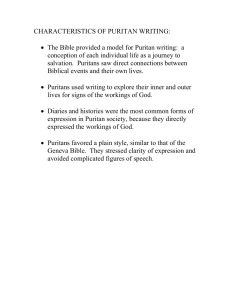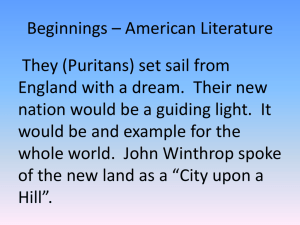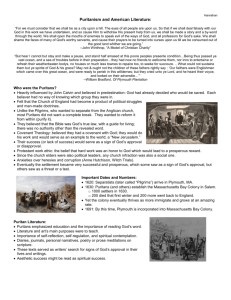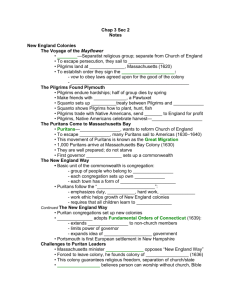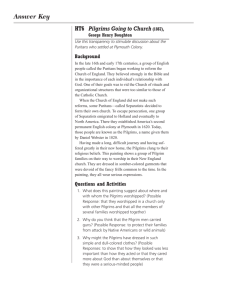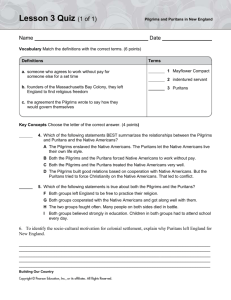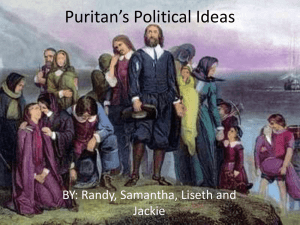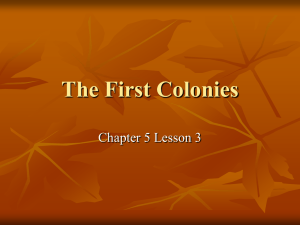Lesson Plan - bostonmitchell
advertisement
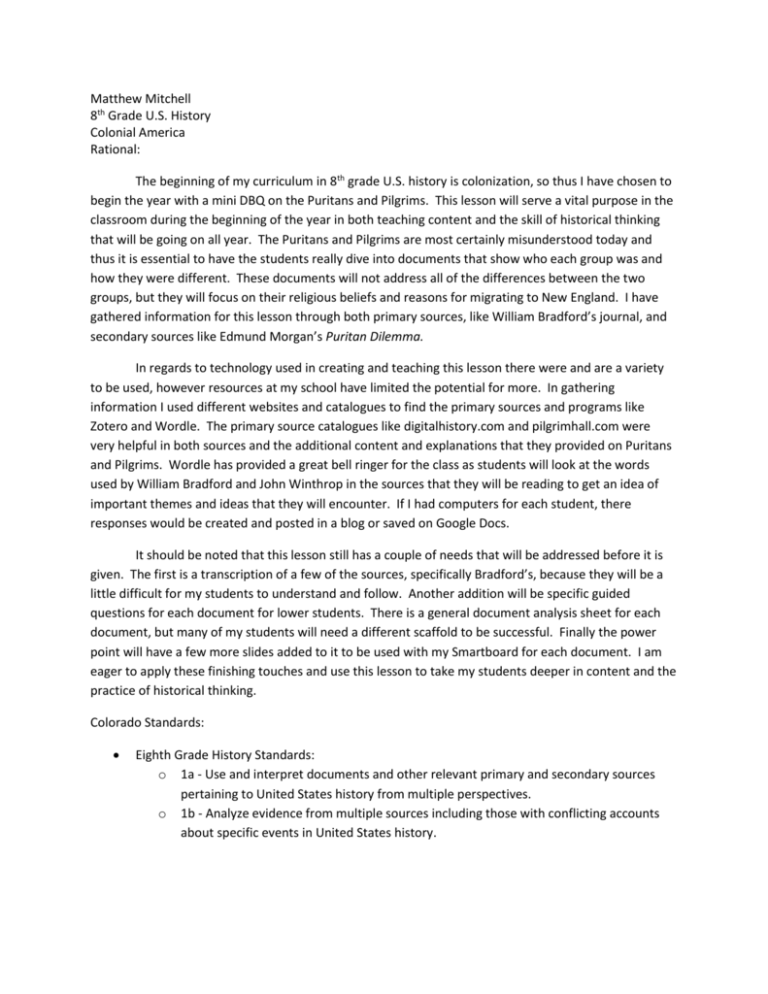
Matthew Mitchell 8th Grade U.S. History Colonial America Rational: The beginning of my curriculum in 8th grade U.S. history is colonization, so thus I have chosen to begin the year with a mini DBQ on the Puritans and Pilgrims. This lesson will serve a vital purpose in the classroom during the beginning of the year in both teaching content and the skill of historical thinking that will be going on all year. The Puritans and Pilgrims are most certainly misunderstood today and thus it is essential to have the students really dive into documents that show who each group was and how they were different. These documents will not address all of the differences between the two groups, but they will focus on their religious beliefs and reasons for migrating to New England. I have gathered information for this lesson through both primary sources, like William Bradford’s journal, and secondary sources like Edmund Morgan’s Puritan Dilemma. In regards to technology used in creating and teaching this lesson there were and are a variety to be used, however resources at my school have limited the potential for more. In gathering information I used different websites and catalogues to find the primary sources and programs like Zotero and Wordle. The primary source catalogues like digitalhistory.com and pilgrimhall.com were very helpful in both sources and the additional content and explanations that they provided on Puritans and Pilgrims. Wordle has provided a great bell ringer for the class as students will look at the words used by William Bradford and John Winthrop in the sources that they will be reading to get an idea of important themes and ideas that they will encounter. If I had computers for each student, there responses would be created and posted in a blog or saved on Google Docs. It should be noted that this lesson still has a couple of needs that will be addressed before it is given. The first is a transcription of a few of the sources, specifically Bradford’s, because they will be a little difficult for my students to understand and follow. Another addition will be specific guided questions for each document for lower students. There is a general document analysis sheet for each document, but many of my students will need a different scaffold to be successful. Finally the power point will have a few more slides added to it to be used with my Smartboard for each document. I am eager to apply these finishing touches and use this lesson to take my students deeper in content and the practice of historical thinking. Colorado Standards: Eighth Grade History Standards: o 1a - Use and interpret documents and other relevant primary and secondary sources pertaining to United States history from multiple perspectives. o 1b - Analyze evidence from multiple sources including those with conflicting accounts about specific events in United States history. Digital Tools Used: In preparation of this lesson: o Zotero o Google Docs o Internet sites for Primary Sources (In bibliography) With the Lesson o Power Point s/projector Objective: I will analyze the differences in religious beliefs and reasons for migration between the Pilgrims and Puritans. Historical Inquiry Question: What are the differences in religious beliefs and reasons for migration between the Pilgrims and Puritans ? Agenda: Task and Allotted Time Bell Work 3 minutes Secondary Source Analysis 10 minutes Document Analysis for the Puritans 15 minutes Whole Group Discussion 10 Minutes Document Analysis for the Pilgrims Student Activities Students will analyze the Puritans and Pilgrims based on a wordle of 2 of the documents to be studied. They need to note what words seem most prevalent and what those words imply about both groups. Have students read the excerpt from Morgan’s Puritan Dilemma and define the basic differences between the Puritans and Pilgrims. Students will analyze Doc A and Doc B in pairs will completing a graphic organizer for analysis. Have students swap partners to compare and discuss findings. Write a summary of what the Puritans believed about religion and why they migrated. Students add info to their overall T-chart for Puritans and Pilgrims. Students will analyze Doc C and Doc D in pairs will complete a Teacher Activities Ensure that students are analyzing the words and thinking critically about what they might mean for the Puritans and Pilgrims. Teacher models how to analyze a document and walks the students through the analysis of the excerpt from Morgan’s Puritan Dilemma. Pass out Documents A and B and the graphic organizers. Aide students with vocabulary and document analysis. Facilitate discussion and comparison. Instruct the students on creating a t-chart for the Pilgrims and Puritans. Pass out Documents C and D and the graphic organizers. Aide graphic organizer for analysis. 15 minutes Whole Group Discussion 10 Minutes Assessment and Application SCR 20 Minutes Have students swap partners to compare and discuss findings. Write a summary of what the Pilgrims believed about religion and why they migrated. Students add info to their overall T-chart for Puritans and Pilgrims. Students need to construct an argument comparing and contrasting the Pilgrims and Puritans using evidence from their documents. students with vocabulary and document analysis. Facilitate discussion and comparison. Have students complete a quick written summary of the Pilgrims in a tchart. Explain what needs to be included in their SCR arguments and assist students as needed. Make sure that they support all of their ideas with evidences. Class Materials Document Analysis Graphic Organizer Guided Questions for each document for lower students (to be created) Documents A – E o 2 for Winthrop and the Puritans o 2 for Bradford and the Pilgrims o 1 Secondary Source from Edmond Morgan’s The Puritan Dilemma Power Point Presentation o With Wordle.com Pictures of Documents o With SCR Prompt (Assessment) Annotated Bibliography 1. “A Model of Christian Charity --- by Gov. John Winthrop, 1630,” http://religiousfreedom.lib.virginia.edu/sacred/charity.html. This site not only was useful for its document, but it also allowed for me to compare it to the version of the source on Digitalhistory.com that had already been modified. 2. “Digital History,” John Winthrop, http://www.digitalhistory.uh.edu/documents/documents_p2.cfm?doc=200. This site was useful for its commentary on Winthrop and the Puritans and it had two documents from Winthrop already modified. However these modifications seemed to focus on the Puritans fear of God and left out the hope that they found. I thus used the site from Virginia.edu to fix this. Also their bibliography and sourcing did not actually state the needed origins of the official document and text, this was a hassle. 3. “Digital History,” William Bradford, http://www.digitalhistory.uh.edu/documents/documents_p2.cfm?doc=219. This site was useful for its commentary on Bradford and the Pilgrims, but like its sources from Winthrop it also lacked quality sourcing of information. 4. “From the Bradford Journal - Emigration,” http://www.pilgrimhall.org/bradfordjournalemigrate.htm. This site was useful in that it gave a few short passages from Bradford’s journal, Of Plimoth Plantaion. These will need to be modified into a more modern friendly language for my students to understand. However I will show students both my transcription and the original text. 5. Wordle.com This site proved worthwhile in helping me create an engaging bell ringer that will get the students heads wrapped around the themes and words chosen by Bradford and Winthrop in the documents that they will read. 6. Edmund S. Morgan, The Puritan Dilemma: The Story of John Winthrop, 3rd ed. (Longman, 2006). This book was an amazing examination of the often misunderstood Puritans. Not only did reading this book expand my knowledge, but it will also be a useful source for my students to access for this lesson. Document E – Excerpt from Edmond Morgan’s The Puritan Dilemma. Please note that his tone is speaking as though he was a Puritan in the 17th Century. Those who did take it [An alternative way to deal with the problem of the Church of England than the Puritans] were called Separatists. They would have nothing to do with the Anglican Church at all –and some went so far as to cut themselves off even more completely by immigration to Holland and then to Plymouth Plantation in New England. Every age has its own separatists. They are the intransigents, the undeviating purists who have to be right whatever the cost, who would sacrifice the world rather than compromise their own righteousness. But most Puritans saw that the problem of sin could not be escaped so easily, and most were sufficiently charitable towed their neighbors to think that England and her churches were still worth saving. The churches were corrupt, yes, but not so corrupt as to lose the name of church. They should be purified of their unregenerate members, their heretical clergymen, their unwarranted ceremonies, their bishops and archbishops, but they were nevertheless churches and must be embraced as churches. They had brought the means of salvation to many of their members and might still do so. To deny them would be to deny Christ and to arrogate a righteousness that belonged only to Him [God]. This was part of the same large paradox that had troubled Winthrop from the beginning, the paradox that required a man to live in the world without being of it. Source: Edmund S. Morgan, The Puritan Dilemma: The Story of John Winthrop, 3rd ed. (Longman, 2006), pg. 27.
